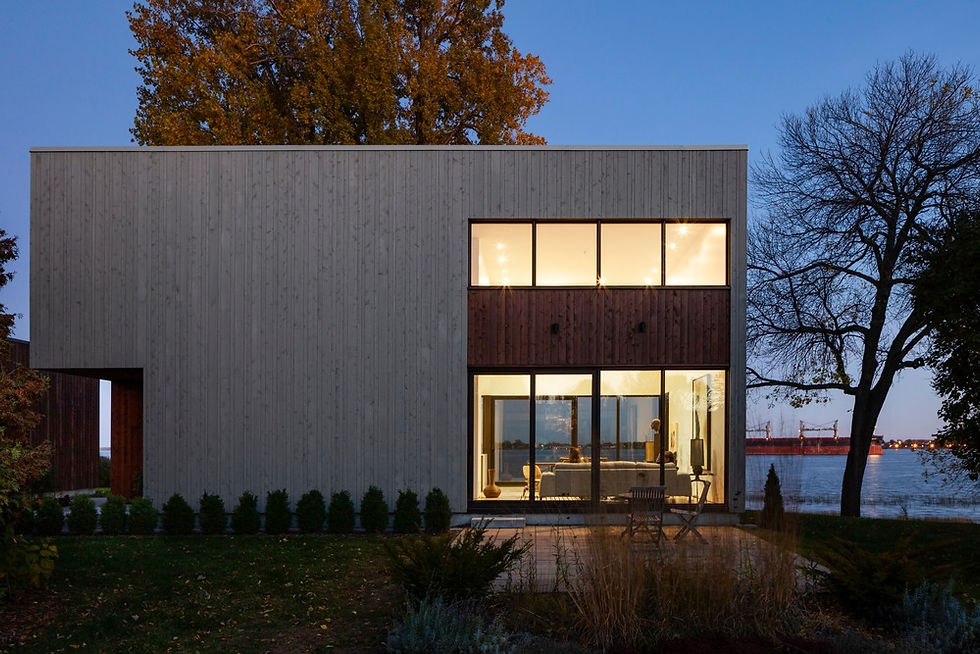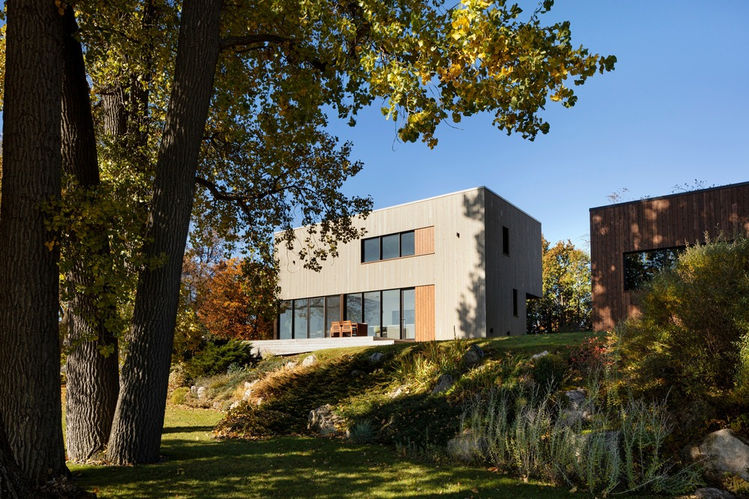
© Maxime Brouillet
PROJECT DETAILS:
KNOW MORE ABOUT THE DESIGNERS:
A rest between two constant movements
Between the road and the river, the St-Ignace house allows you to enjoy the landscapes around it by setting up distinct experiences with unique views that border it. Quietly revealing the St. Lawrence River, it allows you to envisage nature while inhabiting it. Its openings create visual breakthroughs that enhance its environment and place architecture at the service of the landscape.
Strategic location
Located between two industrial hubs, St-Ignace island serves as a natural stopover for residents. Steeped in island traditions, its inhabitants enjoy taking advantage of the proximity of the river in their daily life. It is along a road flanked by farmland and the St. Lawrence River that we find the St-Ignace house. Rippling along the banks, the road sometimes makes way to narrow strips of land nestled between land and sea. It is in one of these breaches that the project is set up, in continuity with the linear landscape that surrounds it. The residence provides a place of respite between two continuous movements, one terrestrial and the other maritime.
The site is naturally detached from the road by a sequence of mature trees, its approach is positioned to maintain this natural screen. Once this strip of vegetation has been crossed, and despite its proximity, the river remains obscured from the view. It is towards a clump of black poplars that the eyes are naturally directed because of the positioning of the two pavilions of the residence. Thus, the arrival on the site makes it viable to highlight the beauty of the vegetation which covers it without the looks being lost, without intermediaries, towards the river.
Set back, the positioning of the house makes it possible to expand the green spaces of the site while blocking direct views of the neighborhood. Cars find themselves outside the possible visual fields from the residence, making it possible to make a break between the constant movement of outdoor life and the serenity of private life. At the heart of the project, a terrace is utilized as a means of access to the house and as a union between the two built volumes. It helps to frame the surrounding vegetation while disguising the St. Lawrence River in the background.
A path to reveal the river
The entrance to the residence is marked by a subtraction from the main volume, forming both a visual cue and a functional shelter from the weather. The dark stained grooved cedar siding marks the entrance to the residence, extending from the outside to the inside to incorporate and distinguish the block of servant spaces from the project. Naturally invited by a long alley to the living room, visitors come across a narrow view revealing the river in the background. This is how the house gently reveals the landscape that surrounds it, gathering attention and unconsciously preparing the visitor for the show to come.
It is by entering the open area on two floors that it’s finally possible to appreciate the river in all its immensity. The large bay windows do more than frame the landscape, they let it pour into the house allowing to enjoy its immensity. The clear ceilings and the omission of partitions amplify this feeling of space and magnitude. In dialogue with the clearing on the river, the bay window of the living room allows you to appreciate a landscape on a different scale, focused on the proximity and the unique characteristics of the vegetation. These two openings on the outside, placed on either side of the space, allow you to feel in communion with the landscapes surrounding the residence.
Magnify landscapes
The outdoor terraces each allow you to enjoy the surrounding landscapes in their own way. The one bordering the living room is refocused on the site, thus being more intimate and isolated. The one next to the dining room and the kitchen exposes the St. Lawrence River in all its magnitude. It allows the ultimate view, without distractions, to the constant movement of this seaway. Despite their positioning on both sides of the main pavilion, the transparency of the volume allows each one to take advantage of the qualities of the other while retaining their unique identity.
Exterior coatings
The residence is covered by cedar slats of two distinct shades. The first are grooved and dark. They are found both inside and set back outside, they want to be the skin of the building, its internal envelope. The second slats act as an outer shell in excess thickness. A set of different widths allows the envelope to be textured randomly, recalling the verticality of the neighboring trees. Made of cedar, the two materials will evolve over the years, slowly, like boats gliding on the river. The second pavilion hosts an artist’s studio, it is covered by dark slats, as if, to express itself freely in the manner of an artist, it was necessary to remove all the protections covering it.
GALLERY:










